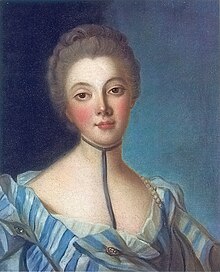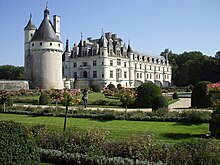Pierre Fidèle Bretonneau
Pierre Fidèle Bretonneau (born April 3, 1778 in Saint-Georges-sur-Cher , near Tours, † February 18, 1862 in Passy , today in Paris ) was a French doctor and worked as a pathologist and epidemiologist .
Live and act
Pierre Fidèle Bretonneau comes from a family that has been active in medicine for several generations. His father Pierre Bretonneau (1741-1811) was a surgeon, maître-chirurgien à Saint-Georges-sur-Cher . He married his second wife and mother of PF Bretonneau Marie-Élisabeth Lecomte (1744-1814) in 1776. She was the daughter of a notary.
One of his uncles, Jean Bretonneau, was also a surgeon from His Highness Monseigneur Prince, Son Altesse Monseigneur le Prince Jules Hercule Meriadec de Rohan-Guéméné (1726–1788), Duke of Montbazon. Another uncle was also a surgeon in Savonnières .
In 1795 he was sent to study at the École de Santé in Paris. During this stay in Paris he established lifelong friendships with André Marie Constant Duméril , Guillaume Dupuytren , Augustin Pyramus de Candolle and Louis Benoît Guersant (1769–1828). There he attended the clinical lectures of Jean-Nicolas Corvisart . Georges Cuvier and Philippe Pinel sparked his interest in the natural sciences and biology. He found a patroness in Madame Dupin at Chenonceau Castle . After her death in 1799 he returned to Paris again.

After a botany exam failed in 1801, he broke off his studies in Paris and turned to military medicine training, became an Officier de Santé in Chenonceaux , and went to Tours, where he successfully worked as a doctor. From 1803 he began to fight against the smallpox or smallpox epidemic, with good success, due to his vaccination campaigns. After successfully completing his military service, he subsequently completed his academic training with a doctorate in Paris on advice and with the prospect of a managerial position at the Tours hospital. On Saturday, January 7th, 1815 he defended his dissertation on De l'utilité de la compression, et en particulier, de l'efficacité du bandage de Théden, dans les inflammations idiopathiques de la peau (translated: On the usefulness of compression and especially the effectiveness of the bandage Théden for idiopathic inflammation of the skin) and received the position of chief physician in Tours . In 1838 he gave up this position in Tours and devoted himself to caring for poor sick people.
On Monday, May 18, 1801, on Place des Vosges in Paris, he married Marie Thérèse Adam (1753 / 1775–1836). Madame Dupin was her great-aunt . As such, Maria Theresa Adam inherited part of the assets of Louise Marie Madeleine Fontaine , Madame Dupin, including a building in Paris, the Chenonceau Castle and a domain. Both moved their center of life to Chenonceaux . From 1803 to 1807 he was mayor, maire, of Chenonceaux.
Bretonneau made friends with Pierre-Jean de Béranger and met regularly in the castle with the former interior minister and owner of Château de Chanteloup, Jean-Antoine Chaptal .

Around 1836 he is said to have had an extramarital relationship with Eugenie Meunier (1801–1873). In 1856 he married for the second time: Sophie Moreau, Comtesse Clary (1837-1918). She was the niece of a former student Jacques-Joseph Moreau .
Bretonneau was a representative of the Paris School of Clinical Medicine. Unlike Xavier Bichat , Bretonneau was of the opinion that inflammation can be distinguished not only with regard to the type of tissue, but also with regard to specific causes. He described diphtheria , which was formerly known as "Bretonneau's disease". The name of the disease, diphtheria, found its way into medical nomenclature in 1826. Bretonneau called it diphtheritis . Between the years 1818 and 1820 there was a diphtheria epidemic in Tours . Bretonneau analyzed the clinical picture thoroughly. He described the typical pseudomembranes of the mucous membranes, which could subsequently lead to shortness of breath, croup and death. He showed that generalized toxic symptoms occurred regardless of the location of the diphtheria infection; they were interpreted by him as an expression of diphtheria-specific inflammation. Bretonneau used the tracheotomy (tracheal incision) for symptomatic therapy . After two frustrating interventions on humans and one successful operation on dogs, he succeeded, in 1825, in performing a successful operation on a four-year-old girl with diphtheria.
His procedure for diphtheric, stridorous airway obstructions of the upper respiratory tract by tracheotomy was adopted by some Parisian hospital doctors , according to Armand Trousseau . He established the tracheotomy as the standard for a complicated course of this disease. In 1852 the Bretonneau student Armand Trousseau performed a total of 169 tracheotomies, 158 of them for croup , and 11 for chronic diseases of the larynx. In the pre-bacteriological era, Bretonneau already suspected that diphtheria was caused by z. B. sharing drinking vessels is passed on.
He also dealt with the typhoid diseases, so he autopsied the dead of a typhoid epidemic in the years 1818 and 1819. In doing so, he discovered important aspects of the pathology of this disease, such as the lesions in the small intestine (destruction of Peyer's plaques in the small intestine) and he called these lesions syndrome de dothiénentérie .
Another student was Alfred-Armand-Louis-Marie Velpeau a French anatomist and surgeon.
Bretonneau had a wide range of interests; he constructed technical devices such as barometers and thermometers, and experimented with endoscopes . He carried out nature observations, for example on bees and ants, and maintained his own botanical garden.
From 1835 he was a corresponding member of the Académie des sciences .
His grave is in the Saint-Cyr-sur-Loire cemetery near Tours.
Fonts (selection)
- De l'utilité de la compression, et en particulier, de l'efficacité du bandage de Théden, dans les inflammations idiopathiques de la peau. Universite de Paris. Faculté de Medicine, 1815.
- The inflammations speciales du tissu muqueux, et en particulier de la diphthérite. Crevot, Paris 1826.
literature
- R. Villey, F. Brunet, G. Valette and others: Histoire de la Médicine, de la Pharmacie, de l'Art Dentaire Vétérinaire. Albin Michel-Laffont-Tchou, Paris 1978.
- Heinz Schott : The Chronicle of Medicine. Chronik Verlag, Munich 1993.
- Gisèle Bretonneau: Nature et valeurs chez Pierre Fidèle Bretonneau. November 24, 1984 de la Société française d'histoire de la médecine. (PDF)
- Émile Aron: Bretonneau: le médecin de Tours. Chambray-les-Tours 1979.
- P. Triaire: Brétonneau et ses correspondants; ouvrage comprenant la correspondance de Trousseau et de Velpeau avec Brétonneau . 2 volumes. Paris 1892. Volume I digitized archive.org Volume II digitized archive.org
Web links
- Literature by and about Pierre Fidèle Bretonneau in the catalog of the German National Library
- RM Debré: Célébration du centenaire de la mort Pierre Fidèle Bretonneau a tours. (1962, (PDF) ( Memento from April 23, 2014 in the Internet Archive ))
- Portrait; Photo taken around 1860 at sciencephoto.com
- Portrait; loire-france.com
- Biography in French loire-france.com
- Short biography in French Pierre-Fidèle BRETONNEAU - 1778-1862 - Clinicien français. ( Memento of August 4, 2012 in the web archive archive.today ) on: medarus.org
Individual evidence
- ↑ biography
- ↑ Barbara I. Tshisuaka: Bretonneau, Pierre Fidèle. In: Werner E. Gerabek , Bernhard D. Haage, Gundolf Keil , Wolfgang Wegner (eds.): Enzyklopädie Medizingeschichte. De Gruyter, Berlin / New York 2005, ISBN 3-11-015714-4 , p. 209.
- ↑ École de santé de Paris, Faculté de médecine de Paris, Société de l'École de médecine correspondancefamiliale.ehess.fr
- ↑ Barbara I. Tshisuaka: Bretonneau, Pierre Fidèle. 2005, p. 209.
- ↑ a b c Wolfgang U. Eckart : Pierre Fidele Bretonneau, in: Wolfgang U. Eckart and Christoph Gradmann (eds.): Ärztelexikon. From antiquity to the present , 3rd edition Springer Heidelberg, 2006, p. 61. Ärztelexikon 2006 , doi : 10.1007 / 978-3-540-29585-3 .
- ↑ Barbara I. Tshisuaka: Bretonneau, Pierre Fidèle. 2005, p. 209.
- ↑ Short biography in English of Alain Rousseau
- ↑ Genealogy of M. Thérèse Adam
- ↑ Genealogy
- ^ Genealogy of Sophie Victorine Eugénie Moreau
- ↑ Christian Byhahn, Volker Lischke, Klaus Westphal (ed.): Tracheotomy. Steinkopf, Darmstadt 2000, p. 7.
- ^ Directory of members since 1666: letter B. Académie des sciences, accessed on February 8, 2020 (French).
| personal data | |
|---|---|
| SURNAME | Bretonneau, Pierre Fidèle |
| BRIEF DESCRIPTION | French doctor |
| DATE OF BIRTH | April 3, 1778 |
| PLACE OF BIRTH | Saint-Georges-sur-Cher near Tours |
| DATE OF DEATH | February 18, 1862 |
| Place of death | Passy |

